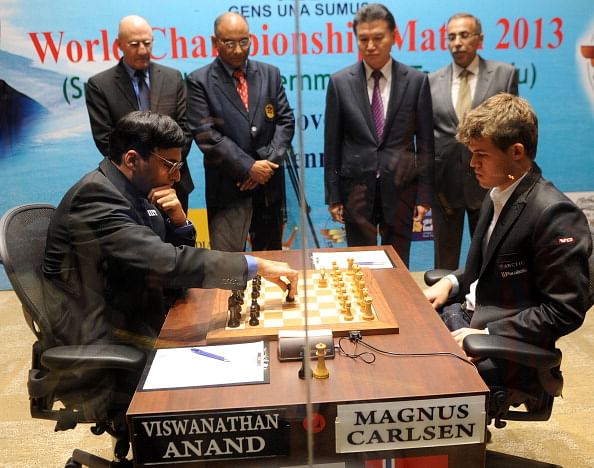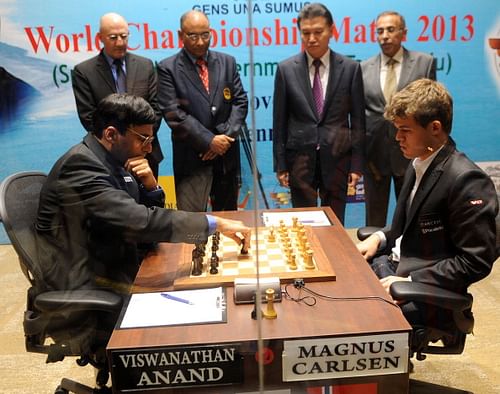
Vishwanathan Anand and Magnus Carlsen: Game one drawn amidst camaraderie and politeness

Vishwanathan Anand and Magnus Carlsen
The FIDE World Championship is off to a sedate start, much against the expectations of a prolonged and heated duel to set the scene for an engaging battle that should keep us all engrossed to the end of this month. Vishwanathan Anand and Magnus Carlsen started the first game with a polite handshake and an engaging conversation about the position on the board at the end. It was an unusual sight for a typically acrimonious duel of this nature where people are used to witness an intensely cold chemistry between the two players. In between, the two players spent about ninety minutes indulging each other in a rather polite debate that ended within 16 moves as the players exchanged another handshake to earn some time off during the evening.
Computer algorithms suggested Anand might be able to build on his situation, but then the world champion must have thought it wasn’t worth the effort so early into this demanding battle against the young Carlsen, especially with black. Carlsen probably missed a trick with the queen on his 13th move and ended up with a position that left him with really no further potential.
The challenger opened the game by moving his knight to f3, opting for the English opening to begin his pursuit of the champion. Being a widely used move, Anand wasted no time moving his pawn to d5. The Reti opening was among predicted selections for the match, but any hopes of Carlsen being able to build the complications needed to trouble Anand were quickly put to bed.
By the 10th move, neither man had a real edge and barely any time was taken off the clock. They did spend some time pondering over the situation but soon realised that there was no real space for an engaging duel. Carlsen opted to repeat his queen even as Anand worked his knight – ending up with a repeated position for the queen at b3 and the knight at a5 to signal the end of the game.
Doordarshan left a lot to be desired, with the team spending too much energy on innuendo instead of speaking about the situation on the board. It did not help either that the board was only partially available on the screens, making it rather meaningless for the viewers. Fans will hope sincerely that the producers get their act together very quickly. Otherwise, it might just be better to find a better feed if available over the internet.
If you haven’t already noted – this shall be a twelve game duel for a $3mn prize, with the winner banking $1.45mn and the loser going home with nearly a million dollars. It is understood that Carlsen has been paid $137,000 to ensure that the tie was played in India. The match will be played in the classical format – two hours for the first 40 moves, followed by an hour for the next twenty. A further 15 minutes will be allowed to complete the game, with an incremental 30 seconds for each move after the 61st move.
Pendyala Harikrishna, the second ranked Indian player behind Anand, assessed the game for the readers of Sportskeeda. “Anand is normally known to respond with Nimzo Indian defence,” said Hari, ” but in this instance opted instead for the Reti defence. That was an interesting development and something that will probably not be lost on Carlsen and his team.” It is likely to be an insight into the Indian’s strategy for this match, felt the 27 year old man who held Anand to a draw at the Tata Steel Chess Tournament in Wijk Aan Zee earlier this year.
Carlsen surprised the pundits by opting to move his pawn to b3 on the sixth move. And by the eighth move, the board transposed into a Neo-Grunfeld like situation, with black already looking like the steadier of the two players. Harikrishna also felt that the ninth move by Anand was curious, considering that a lot of top level players hadn’t used it in competition. The exchange of pawns at c4, left Carlsen without too many development options and the challenger recognised that immediately.
The world champion underlined the strength of his preparations when he played his knight to c4 on the eleventh move followed by Nd5 to limit the options of his opponent. The Norwegian decided that was enough for the day, choosing to repeat and push the game into a draw. The two players did so with the queen (white) and knight (black).
Carlsen toggled the queen between b3 and a3, Anand responding by moving his knight to a5 and c4 to signal a quick draw. Overall though, Harikrishna felt that while it was a good result for Anand, since he was playing black, it wasn’t also such a poor result for the world No.1. But closer to the venue, one has a feeling that Carlsen might feel that he may have underutilised white in his first championship outing.
Game 2 will be played tomorrow inside the insulated glass cage at the Hyatt Regency in Chennai. Anand will have the advantage of playing white on Sunday. The game will be closely watched to see how Anand might open, as experts remain hawk eyed to read into the strategies of the two players.